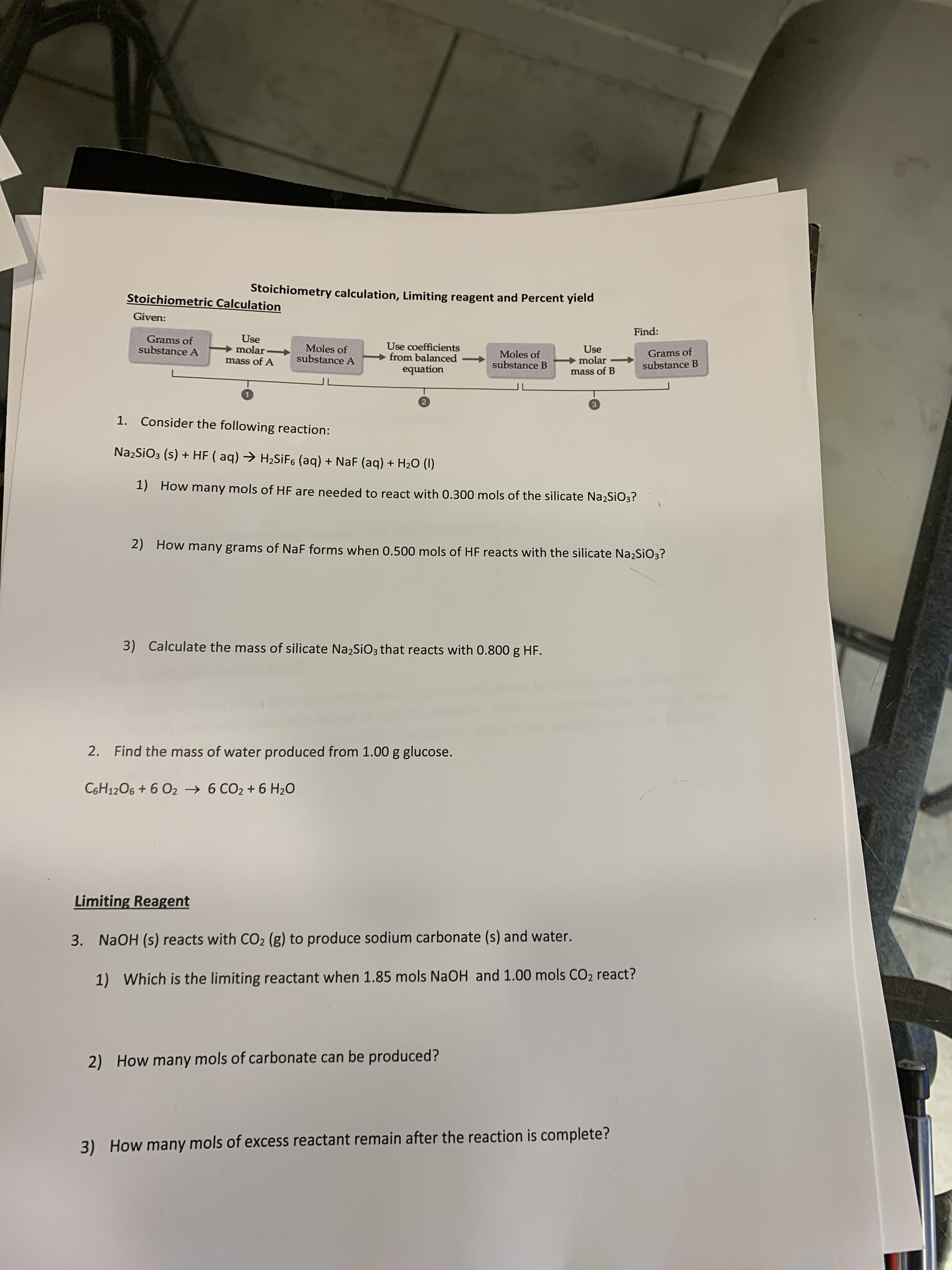Stoichiometry calculation, Limiting reagent and Percent yield Stoichiometric Calculation Given: Find: Use molar mass of A Grams of substance A Use coefficients from balanced Moles of substance A Use molar mass of B Grams of Moles of substance B substance B equation 3. 1. Consider the following reaction: NazSiO3 (s) + HF ( aq) → H2SIF6 (aq) + NaF (aq) + H2O (I) 1) How many mols of HF are needed to react with 0.300 mols of the silicate Na2SiO3? 2) How many grams of NaF forms when 0.500 mols of HF reacts with the silicate NazSiO3? Calculate the mass of silicate Na2SiO3 that reacts with 0.800 g HF. 3) 2. Find the mass of water produced from 1.00 g glucose. C6H1206 + 6 O2 → 6 CO2 + 6 H20 Limiting Reagent NaOH (s) reacts with CO2 (g) to produce sodium carbonate (s) and water. 3. Which is the limiting reactant when 1.85 mols NaOH and 1.00 mols CO2 react? 1) How many mols of carbonate can be produced? 2) How many mols of excess reactant remain after the reaction is complete? 3)
Stoichiometry calculation, Limiting reagent and Percent yield Stoichiometric Calculation Given: Find: Use molar mass of A Grams of substance A Use coefficients from balanced Moles of substance A Use molar mass of B Grams of Moles of substance B substance B equation 3. 1. Consider the following reaction: NazSiO3 (s) + HF ( aq) → H2SIF6 (aq) + NaF (aq) + H2O (I) 1) How many mols of HF are needed to react with 0.300 mols of the silicate Na2SiO3? 2) How many grams of NaF forms when 0.500 mols of HF reacts with the silicate NazSiO3? Calculate the mass of silicate Na2SiO3 that reacts with 0.800 g HF. 3) 2. Find the mass of water produced from 1.00 g glucose. C6H1206 + 6 O2 → 6 CO2 + 6 H20 Limiting Reagent NaOH (s) reacts with CO2 (g) to produce sodium carbonate (s) and water. 3. Which is the limiting reactant when 1.85 mols NaOH and 1.00 mols CO2 react? 1) How many mols of carbonate can be produced? 2) How many mols of excess reactant remain after the reaction is complete? 3)
Chemistry: Principles and Practice
3rd Edition
ISBN:9780534420123
Author:Daniel L. Reger, Scott R. Goode, David W. Ball, Edward Mercer
Publisher:Daniel L. Reger, Scott R. Goode, David W. Ball, Edward Mercer
Chapter5: Thermochemistry
Section: Chapter Questions
Problem 5.100QE
Related questions
Question

Transcribed Image Text:Stoichiometry calculation, Limiting reagent and Percent yield
Stoichiometric Calculation
Given:
Find:
Use
molar
mass of A
Grams of
substance A
Use coefficients
from balanced
Moles of
substance A
Use
molar
mass of B
Grams of
Moles of
substance B
substance B
equation
3.
1.
Consider the following reaction:
NazSiO3 (s) + HF ( aq) → H2SIF6 (aq) + NaF (aq) + H2O (I)
1)
How many mols of HF are needed to react with 0.300 mols of the silicate Na2SiO3?
2)
How many grams of NaF forms when 0.500 mols of HF reacts with the silicate NazSiO3?
Calculate the mass of silicate Na2SiO3 that reacts with 0.800 g HF.
3)
2.
Find the mass of water produced from 1.00 g glucose.
C6H1206 + 6 O2 → 6 CO2 + 6 H20
Limiting Reagent
NaOH (s) reacts with CO2 (g) to produce sodium carbonate (s) and water.
3.
Which is the limiting reactant when 1.85 mols NaOH and 1.00 mols CO2 react?
1)
How many mols of carbonate can be produced?
2)
How many mols of excess reactant remain after the reaction is complete?
3)
Expert Solution
This question has been solved!
Explore an expertly crafted, step-by-step solution for a thorough understanding of key concepts.
This is a popular solution!
Trending now
This is a popular solution!
Step by step
Solved in 4 steps with 4 images

Recommended textbooks for you

Chemistry: Principles and Practice
Chemistry
ISBN:
9780534420123
Author:
Daniel L. Reger, Scott R. Goode, David W. Ball, Edward Mercer
Publisher:
Cengage Learning

Chemistry: Principles and Practice
Chemistry
ISBN:
9780534420123
Author:
Daniel L. Reger, Scott R. Goode, David W. Ball, Edward Mercer
Publisher:
Cengage Learning